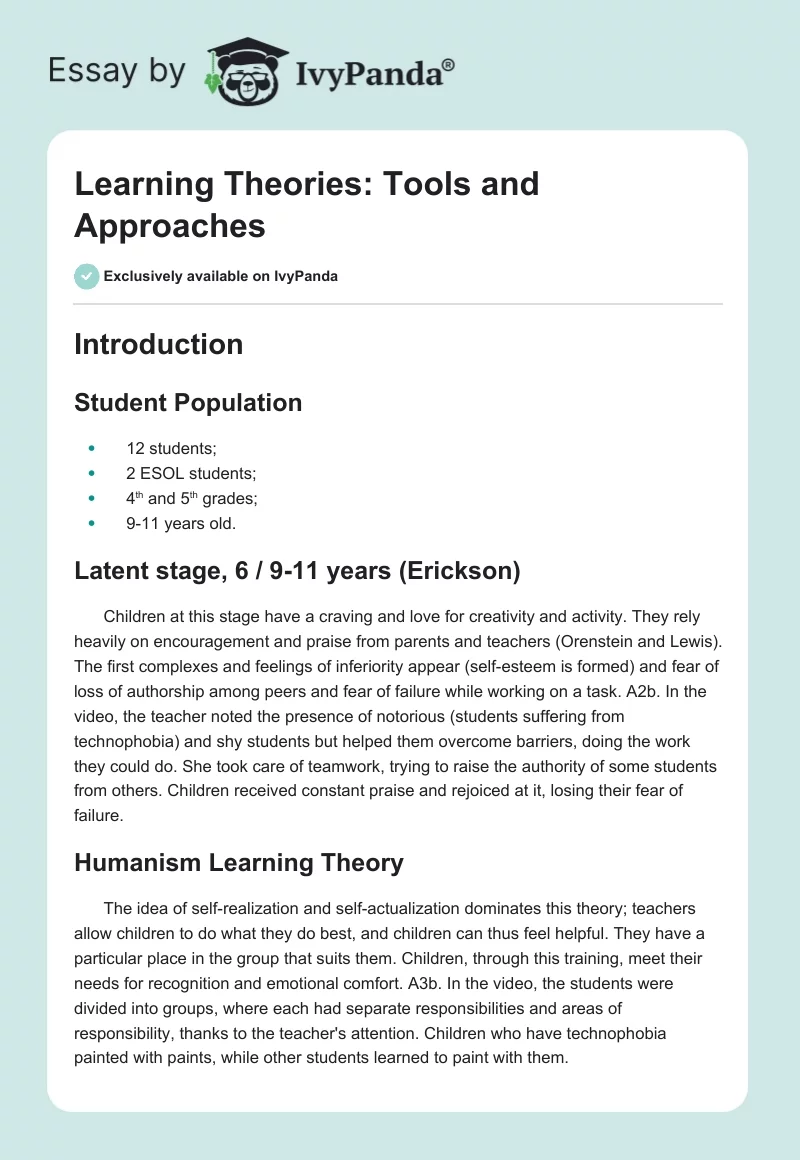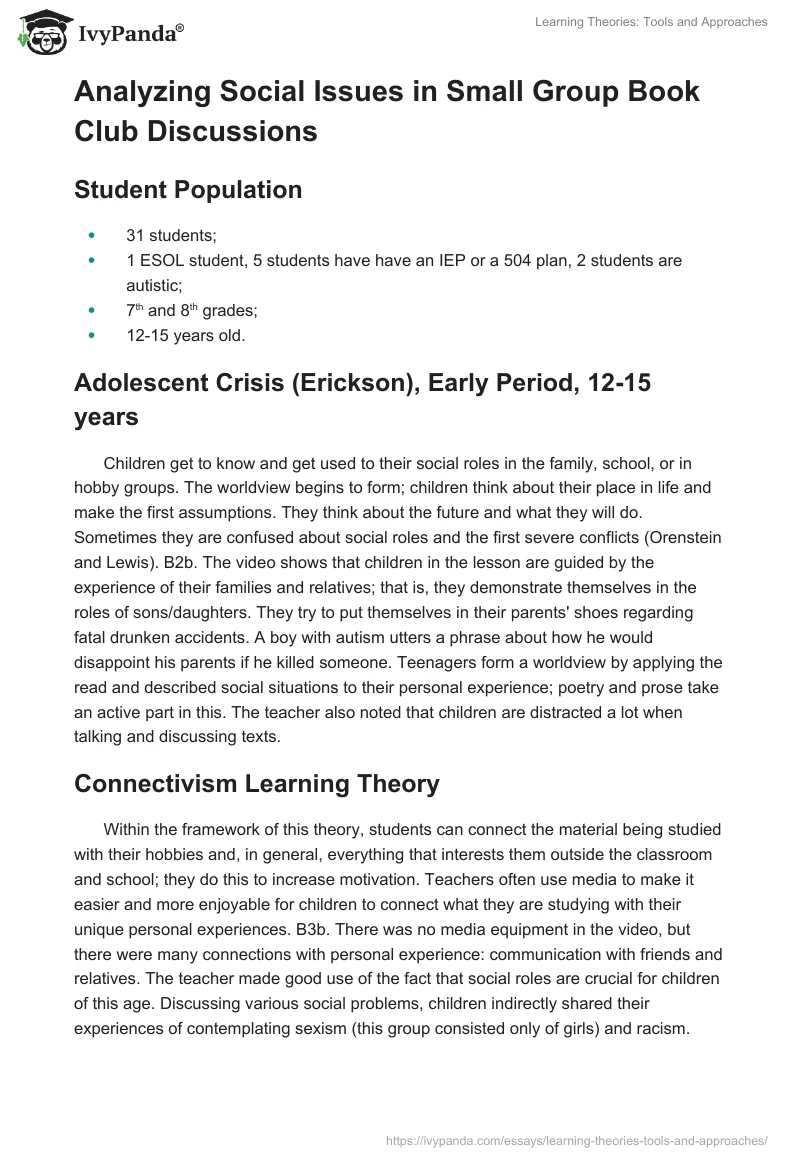Introduction
Student Population
- 12 students;
- 2 ESOL students;
- 4th and 5th grades;
- 9-11 years old.
Latent stage, 6 / 9-11 years (Erickson)
Children at this stage have a craving and love for creativity and activity. They rely heavily on encouragement and praise from parents and teachers (Orenstein and Lewis). The first complexes and feelings of inferiority appear (self-esteem is formed) and fear of loss of authorship among peers and fear of failure while working on a task. A2b. In the video, the teacher noted the presence of notorious (students suffering from technophobia) and shy students but helped them overcome barriers, doing the work they could do. She took care of teamwork, trying to raise the authority of some students from others. Children received constant praise and rejoiced at it, losing their fear of failure.
Humanism Learning Theory
The idea of self-realization and self-actualization dominates this theory; teachers allow children to do what they do best, and children can thus feel helpful. They have a particular place in the group that suits them. Children, through this training, meet their needs for recognition and emotional comfort. A3b. In the video, the students were divided into groups, where each had separate responsibilities and areas of responsibility, thanks to the teacher’s attention. Children who have technophobia painted with paints, while other students learned to paint with them.
Analyzing Social Issues in Small Group Book Club Discussions
Student Population
- 31 students;
- 1 ESOL student, 5 students have have an IEP or a 504 plan, 2 students are autistic;
- 7th and 8th grades;
- 12-15 years old.
Adolescent Crisis (Erickson), Early Period, 12-15 years
Children get to know and get used to their social roles in the family, school, or in hobby groups. The worldview begins to form; children think about their place in life and make the first assumptions. They think about the future and what they will do. Sometimes they are confused about social roles and the first severe conflicts (Orenstein and Lewis). B2b. The video shows that children in the lesson are guided by the experience of their families and relatives; that is, they demonstrate themselves in the roles of sons/daughters. They try to put themselves in their parents’ shoes regarding fatal drunken accidents. A boy with autism utters a phrase about how he would disappoint his parents if he killed someone. Teenagers form a worldview by applying the read and described social situations to their personal experience; poetry and prose take an active part in this. The teacher also noted that children are distracted a lot when talking and discussing texts.
Connectivism Learning Theory
Within the framework of this theory, students can connect the material being studied with their hobbies and, in general, everything that interests them outside the classroom and school; they do this to increase motivation. Teachers often use media to make it easier and more enjoyable for children to connect what they are studying with their unique personal experiences. B3b. There was no media equipment in the video, but there were many connections with personal experience: communication with friends and relatives. The teacher made good use of the fact that social roles are crucial for children of this age. Discussing various social problems, children indirectly shared their experiences of contemplating sexism (this group consisted only of girls) and racism.
Considering Changes to Immigration Policy Through Interest Group Input
Student Population
- 31 students;
- more than half of students are fluent in more than one language;
- most of the students are Asians;
- 17-18 years old.
Adolescent Crisis (Erickson), Late Period, 16-20 years
C2a. Teenagers are often confident in their worldview in their position. They know how to express and prove their point of view reasonably and possess abstract concepts; they can use complex scientific categories (Orenstein and Lewis). C2b. In the videos, children sometimes used sociological and political sociology. They discussed political news, and the teacher noted that children often watch TV and read the information on the Internet, especially when they are concerned about immigration. Children relied on their personal experience (and the experience of their families), which had already influenced their worldview.
Constructivism Learning Theory
C3a. Children bring their accumulated experience to the learning process, complementing it and making it unique. By combining personal experience and theoretical material, they create their knowledge. This knowledge subsequently becomes a pillar of their understanding of the world around them. C3b. In the video, children shared their families’ experiences who experienced (often brutal, illegal) immigration. This experience shaped their worldview in a certain way that conflicted with the worldviews of other children. The children understood that, due to their unique experiences, they could be biased towards others and their opinions. Children could competently include in learning the knowledge of their childhood and stories of their parents. They expertly analyzed their past and wondered about identity and citizenship; children emotionally expressed their feelings about their experiences.
Developing a Paragraph for Journal Writing
Student Population
Classes are held one-on-one with a teacher and a 12-year-old girl named Kassedy, who was diagnosed with autism about 10 years ago.
The Beginning of the Concrete Operational Stage (Piaget), Combined with High Anxiety
D2a. Children usually love and know how to use gadgets (phones and tablets) at this stage. The use of logic is minimal, and abstract thinking is not yet developed (McLeod). In new topics in their studies, children feel timid and constrained. D2b. The video examines an example of a girl whose developmental stage, due to autism, does not correspond to her physical age. Determination of the stage was seriously complicated by Cassidy’s timidity, fearfulness, and anxiety. The teacher notes her fear; his actions are not aimed directly at teaching but at relieving Kassedy of stress. Kassedy thinks only figuratively, often always uses cards with pictures. The lesson, however, uses the technique, and the teacher notes that Kassedy knows how to use some of the programs she finds interesting.
Cognitive Learning Theory
Teachers pay increased attention to the child’s thinking and arrive at specific answers. This theory puts in the center the question of understanding and understanding the material and the surrounding world in general. Teachers enable children to think aloud and ask leading questions to follow their thoughts. D3b. In the video, Kassedy’s teacher patiently watched, helped, and suggested how she could write a short paragraph about gardening. He tried to think with Kassedy; based on her anxiety and thinking ability, he chose the task well before recording the video.
Knowledge of developmental psychology allows teachers to track student progress and guide them competently over time teaching. Understanding the capabilities of the children in the third video, the teacher correctly selected specific questions for discussion. The teacher for the subsequent perspective helped the students to form a worldview.
Understanding the levels of development allows you to choose a learning model correctly. With the right approach, children will quickly and comfortably assimilate information. The teacher’s preferred method in the first video allowed young students to work together and in a psychologically comfortable environment. Her attitude and care are suitable for this level of development, and older children would seem intrusive.
Conclusion
Learning theories help teachers with a variety of tools and approaches. These theories make the literate teacher flexible and ready to work with any child. The idea of connectivism can be used when working with adolescents and discussing social issues.
Works Cited
McLeod, S. (2018). Piaget’s theory and stages of cognitive development.Developmental Psychology, Simply Psychology. Web.
Orenstein, Gabriel A., and Lindsay Lewis. “Eriksons stages of psychosocial development.” StatPearls [Internet] (2020).


